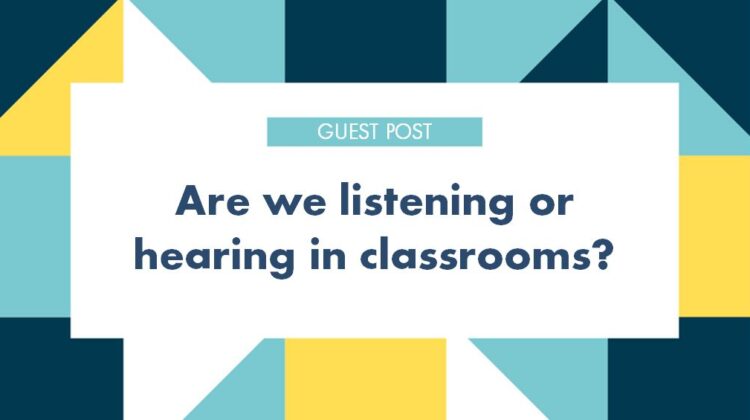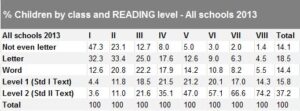
There seems to be a universal agreement with the fact that proper acoustic treatment of a classroom will enhance comprehension abilities of its audience. This is more true with children as occupants compared with adults.
To understand better, let’s first look at how our brain perceives sound. The adult brain takes all sounds we hear and separates them source-wise and then focuses on the one we want to hear. Adults usually hear in a narrow band of sound, while children seem to use a different approach. They don’t have the selective attention of adults and they don’t pay attention all the time. Instead, they always seem to be listening to broadband or to all frequencies simultaneously!
In a child’s learning curve, adequate speech recognition is essential for learning. Younger children are the most vulnerable population, more affected by unfavourable listening environments because of their developing auditory and linguistic systems.[2] In addition, children with conductive or sensory-neural hearing loss (unilateral or bilateral), speech and language disorders, reading disorder, learning difficulties, central auditory processing deficits, developmental delays or attention deficits exhibit more perceptual difficulties in typical classroom environments than other children.[2,3]
The importance of classroom listening conditions has been explored for the past four decades, and it was reported that a good listening environment facilitated improved speech perception. Apart from enhancing concentration, good acoustics positively affects the productivity of teachers, learning abilities of students and general health of students and teachers, both. Noise produces fatigue. Fatigue leads to inattention.
Classrooms that have poor acoustical design are noisy. Noise disrupts the learning process.
Conversely, students who are listening well and who remain engaged, continue to learn!
Classroom acoustics, the Indian context
In India, most government and private schools lack infrastructure besides other problems. So the idea of acoustical treatment of classrooms may be considered impractical by many as they consider it to be an expensive affair. It need not be so, especially when one realises that the advantages may outweigh the trouble with nominal initial investment associated with acoustic treatment. Having said that, particularly for government-owned schools, care must also be taken by consultants to see that acoustic solutions should be as affordable as possible.

Looking at school education in India, evidence suggests that learning outcomes for children in Indian schools are below corresponding class levels in other countries. Program for International Student Assessment (PISA) (2012) places India second from the bottom out of 73 countries. In addition, a national survey conducted by ASER (2014) also corroborates the low levels of learning by children in schools.
It needs to be found out though what contribution acoustics has on such performance. These facts along with above-mentioned factors make us believe that NOW is the time to improve classroom acoustics in India. There are many widely accepted international codes such as ANSI S12.60-2002 that deal with classroom acoustics. But they may not be comprehensively beneficial in dealing with Indian classroom situations. A somewhat tailor-made approach may be the need of the hour.
A typical example is the unique phonetics of Indian languages that are most widely adopted in teaching and informal communication. Special emphasis is to be placed upon how certain vowels, consonants, and word combinations are pronounced in the local language and how they would be perceived by children with and without acoustic treatment.
For representational purposes, let’s consider the speech contours that show the directional characteristics of human speech (in English) at low frequencies (<500 Hz to represent vowels) and at high frequencies(>4000 Hz to represent consonants). There is some loss of sound level at sides (6 dB) for high frequencies and considerable loss (20dB) at the rear. This readily suggests teachers must generally refrain from strolling down the aisle and not speak with their backs facing students during lecture. Similar novel investigations must also be performed on phonetics of Indian local languages to test and measure how they behave in non-acoustic (vs) acoustically treated environments.
Even a casual examination of a typical Indian classroom would point us to things that can be rectified straight away. If, and only if, all the openings (doors, windows etc.) are completely sealed off in closed positions, external noise can be isolated to a good degree. Simple measures such as filling the room liberally with bookshelves, placing fabric based bulletin boards all over walls etc., could control reverberation to some extent. Unoccupied classroom reverberation time shall not exceed 0.6 seconds for average size classrooms or 0.7 seconds in larger rooms (ANSI/ASA, 2010; 2009).
The acoustics of classrooms affects teachers both physiologically and psychologically. It may cause several health issues in teachers including deteriorating hearing, stress-related symptoms, and annoyance.[4] Teachers have also reported issues related to vocal health that included hoarseness, fatigue, discomfort when using their voice for speaking or singing, difficulty in projecting their voice, vocal monotony, effortful speaking, chronic throat dryness and soreness, frequent throat clearing and swallowing difficulties.[5] These issues are commonly attributed to increased vocal loudness when conversing in the presence of a background noise. The idea is to keep both teachers and students at ease with good acoustics.
Policy
There is a great awareness problem with respect to classroom acoustics in our country. Acoustic parameters have been missing in policy documents in India such as regulations related to recognition, affiliation, accreditation, and inspection. It is also not found as a part of teacher training curriculum. A ready look at State level education codes of many states reveals that acoustics of classrooms is not given the due importance. There are several other Indian codes (NBC 2005, IS 2006 & GRIHA 2014) that touch upon acoustic standards to be maintained in classroom settings. Except for providing acceptable noise levels (40-45 dBA), nothing much has been addressed within them.
Given that the acoustic environment has such huge bearing on children and teachers, it is high time that these codes stay relevant by addressing all of the core acoustic design requirements.
Parameters such as reverberation time (RT), signal to noise ratio (S/N), background noise specification (NC) etc., must be added to design specifications. Considering that younger children are most affected by acoustics because of their developing auditory systems, codes need to be segregated into categories such as pre-primary, primary, secondary and college, based on the age of target students.
A good listening and teaching environment can be achieved by using sound field amplification and sound absorption materials in the classroom, as well as considering noise issues when designing schools. Further study of the acoustic environment of schools in different regions of India and ways to improve this environment is necessary.
Post by:


Naveen Kuppa, Acoustic Consultant and Srinivas Kuppa, HVAC & Energy Consultant, Design Corp Acoustics and Lighting Consultants.
REFERENCES
1. Choi CY, McPherson B. Noise levels in Hong Kong primary schools: Implications for classroom listening. Int J Disabil Dev Educ. 2005;52:345–60.
2. Nelson PB, Soli SD, Seltz A. Classroom Acoustics II: Acoustical Barriers to Learning. Melville, NY: Acoustical Society of America; 2002. [Last cited on 2016 Dec 1].
3. Crandell CC, Smaldino JJ. Classroom acoustics for children with normal hearing and with hearing impairment. Lang Speech Hear Serv Sch. 2000;31:362–70.
4. Enmarker I, Boman E. Noise annoyance responses of middle school pupils and teachers. J Environ Psychol. 2004;24:527–36.
5. Roy N, Merrill RM, Thibeault S, Gray SD, Smith EM. Voice disorders in teachers and the general population: Effects on work performance, attendance, and future career choices. J Speech Lang Hear Res. 2004;47:542–51
6. National Buildings Code of India. Bureau of Indian Standards. 2005.
7. American Speech Language Hearing Association. Guidelines for Addressing Acoustics in Educational Settings; 2005.
8. Classroom Listening Conditions in Indian Primary Schools: A Survey of Four Schools Gayathri Sundaravadhanan,1 Heramba G. Selvarajan,1 and Bradley McPherson2
9. Dr. Veera Gupta, Policy on Classroom Acoustics in India, DEI-FOERA A Research Journal in Education, Annual Issue 8, Jan 31, 2015, ISSN No. 0974-796
10. Can you hear me? Shefali Shah, http://www.teacherplus.org
11. World Health Organization. Guidelines for Community Noise. 1999.
12. American National Standards Institute. Acoustical Performance Criteria, Design, Requirements, and Guidelines for Schools (ANSIS12. 60-2002) New York: American National Standards Institute; 2002

